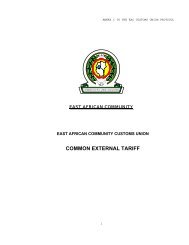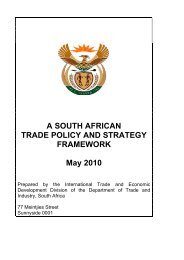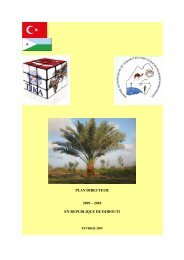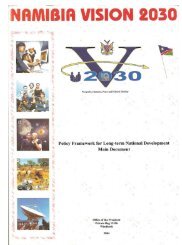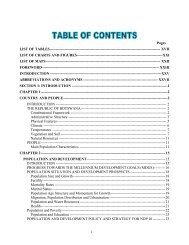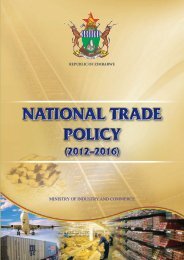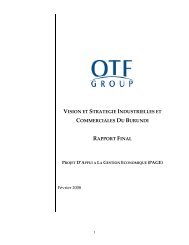- Page 1 and 2: EAST AFRICAN COMMUNITY COMMON EXTER
- Page 3 and 4: SECTION III ANIMAL OR VEGETABLE FAT
- Page 5 and 6: SECTION VIII RAW HIDES AND SKINS, L
- Page 7 and 8: SECTION XIII ARTICLES OF STONE, PLA
- Page 9: 92 Musical instruments; parts and a
- Page 13 and 14: Section I LIVE ANIMALS; ANIMAL PROD
- Page 15 and 16: Chapter 2 Meat and edible meat offa
- Page 17 and 18: Heading No. H.S. Description Code/T
- Page 19 and 20: Chapter 3 Fish and crustaceans, mol
- Page 21 and 22: Heading No. H.S. Description Code/T
- Page 23 and 24: Heading No. H.S. Description Code/T
- Page 25 and 26: Heading No. H.S. Description Code/T
- Page 27 and 28: Heading No. H.S. Description Code/T
- Page 29 and 30: Chapter 5 Products of animal origin
- Page 31 and 32: Heading No. H.S. Description Code /
- Page 33 and 34: Heading No. H.S. Code/Tariff No. De
- Page 35 and 36: Heading No. H.S. Code/Tariff No. De
- Page 37 and 38: Heading No. H.S. Code/Tariff No. De
- Page 39 and 40: Heading No. H.S. Code/Tariff No. De
- Page 41 and 42: Heading No. H.S. Code/Tariff No. De
- Page 43 and 44: Heading No. H.S. Code/Tariff No. De
- Page 45 and 46: Heading No. H.S. Description Code/T
- Page 47 and 48: Heading No. H.S. Description Code/T
- Page 49 and 50: Chapter 12 Oil seeds and oleaginous
- Page 51 and 52: Heading No. H.S. Code/Tariff No. De
- Page 53 and 54: Chapter 13 Lac; gums, resins and ot
- Page 55 and 56: Chapter 14 Vegetable plaiting mater
- Page 57 and 58: Heading No. H.S. Description Code/T
- Page 59 and 60: Heading No. H.S. Description Code/T
- Page 61 and 62:
Heading No. H.S. Code/Tariff No. De
- Page 63 and 64:
Heading No. H.S. Description Code/T
- Page 65 and 66:
Chapter 19 Preparations of cereals,
- Page 67 and 68:
Heading No. H.S. Code/Tariff No. De
- Page 69 and 70:
Heading No. H.S. Code/Tariff No. De
- Page 71 and 72:
Heading No. H.S. Code/Tariff No. De
- Page 73 and 74:
Heading No. H.S. Code/Tariff No Des
- Page 75 and 76:
Heading No. H.S. Description Code/T
- Page 77 and 78:
Chapter 23 Residues and waste from
- Page 79 and 80:
Chapter 24 Tobacco and manufactured
- Page 81 and 82:
Heading No. H.S. Code/Tariff No. De
- Page 83 and 84:
Heading No. H.S. Code/Tariff No. De
- Page 85 and 86:
Heading No. H.S. Code/Tariff No. De
- Page 87 and 88:
Heading No. H.S. Description Code/T
- Page 89 and 90:
Chapter 27 Mineral fuels, mineral o
- Page 91 and 92:
Heading No. H.S. Description Code/T
- Page 93 and 94:
Heading No. H.S. Description Code/T
- Page 95 and 96:
Chapter 28 Inorganic chemicals; org
- Page 97 and 98:
Heading No. H.S. Code/Tariff No. De
- Page 99 and 100:
Heading No. H.S. Code/Tariff No. De
- Page 101 and 102:
Heading No. H.S. Code/Tariff No. De
- Page 103 and 104:
Heading No. H.S. Code/Tariff No. De
- Page 105 and 106:
Heading No. H.S. Code/Tariff No. De
- Page 107 and 108:
4.- In headings. 29.04 to 29.06, 29
- Page 109 and 110:
Heading No. H.S. Description Code/T
- Page 111 and 112:
Heading No. H.S. Description Code/T
- Page 113 and 114:
Heading No. H.S. Description Code/T
- Page 115 and 116:
Heading No. H.S. Description Code/T
- Page 117 and 118:
Heading No. H.S. Description Code/T
- Page 119 and 120:
Heading No. H.S. Description Code/T
- Page 121 and 122:
Heading No. H.S. Description Code/T
- Page 123 and 124:
Heading No. H.S. Description Code/T
- Page 125 and 126:
Heading No. H.S. Description Code/T
- Page 127 and 128:
Heading No. H.S. Description Code/T
- Page 129 and 130:
(g) (h) (ij) First-aid boxes and ki
- Page 131 and 132:
Heading No. H.S. Code/Tariff No. De
- Page 133 and 134:
4.- Heading 31.04 applies only to t
- Page 135 and 136:
Chapter 32 Tanning or dyeing extrac
- Page 137 and 138:
Heading No. H.S. Description Code/T
- Page 139 and 140:
Chapter 33 Essential oils and resin
- Page 141 and 142:
Heading No. H.S. Description Code/T
- Page 143 and 144:
Heading No. H.S. Description Code/T
- Page 145 and 146:
Chapter 35 Albuminoidal substances;
- Page 147 and 148:
Chapter 36 Explosives; pyrotechnic
- Page 149 and 150:
Heading No. H.S. Description Code/T
- Page 151 and 152:
Chapter 38 Chapter Notes. Miscellan
- Page 153 and 154:
Heading No. H.S. Code/Tariff No. De
- Page 155 and 156:
Heading No. H.S. Code/Tariff No. De
- Page 157 and 158:
Heading No. H.S. Code/Tariff No. De
- Page 159 and 160:
Section VII PLASTICS AND ARTICLES T
- Page 161 and 162:
9.- For the purposes of heading 39.
- Page 163 and 164:
Heading No. H.S. Code/Tariff No. De
- Page 165 and 166:
Heading No. H.S. Code/Tariff No. De
- Page 167 and 168:
Heading No. H.S. Code/Tariff No. De
- Page 169 and 170:
Heading No. H.S. Code/Tariff No. De
- Page 171 and 172:
Heading No. H.S. Code/Tariff No. De
- Page 173 and 174:
(iii) very small amounts of the fol
- Page 175 and 176:
Heading No. H.S. Description Code/T
- Page 177 and 178:
Heading No. H.S. Description Code/T
- Page 179 and 180:
Section VIII RAW HIDES AND SKINS, L
- Page 181 and 182:
Heading No. H.S. Code/Tariff No. De
- Page 183 and 184:
Chapter 42 Articles of leather; sad
- Page 185 and 186:
Heading No. H.S. Description Code/T
- Page 187 and 188:
Heading No. H.S. Code/Tariff No. De
- Page 189 and 190:
6.- Subject to Note 1 above and exc
- Page 191 and 192:
Heading No. H.S. Description Code/T
- Page 193 and 194:
Heading No. H.S. Description Code/T
- Page 195 and 196:
Chapter 46 Manufactures of straw, o
- Page 197 and 198:
Section X PULP OF WOOD OR OF OTHER
- Page 199 and 200:
Chapter 48 Paper and paperboard; ar
- Page 201 and 202:
(iv) Covered on the face side with
- Page 203 and 204:
Heading No. H.S. Description Code/T
- Page 205 and 206:
Heading No. H.S. Description Code/T
- Page 207 and 208:
Heading No. H.S. Description Code/T
- Page 209 and 210:
Heading No. H.S. Description Code/T
- Page 211 and 212:
Heading No. H.S. Description Code/T
- Page 213 and 214:
Section XI TEXTILES AND TEXTILE ART
- Page 215 and 216:
(i) (ii) 85 g in the case of silk,
- Page 217 and 218:
(ii) (iii) (iv) consists of a mixtu
- Page 219 and 220:
Chapter 50 Silk __________ Heading
- Page 221 and 222:
Heading No. H.S. Code/Tariff No. De
- Page 223 and 224:
Chapter 52 Cotton Subheading Note.
- Page 225 and 226:
Headin g No. H.S. Code/Tariff No. D
- Page 227 and 228:
Headin g No. H.S. Code/Tariff No. D
- Page 229 and 230:
Headin g No. H.S. Code/Tariff No. D
- Page 231 and 232:
Chapter 53 Other vegetable textile
- Page 233 and 234:
Chapter 54 Man-made filaments; stri
- Page 235 and 236:
Heading No. H.S. Description Code/T
- Page 237 and 238:
Heading No. H.S. Description Code/T
- Page 239 and 240:
Heading No. H.S. Description Code/T
- Page 241 and 242:
Heading No. H.S. Description Code/T
- Page 243 and 244:
Heading No. H.S. Description Code/T
- Page 245 and 246:
Chapter 56 Wadding, felt and nonwov
- Page 247 and 248:
Heading No. H.S. Description Code/T
- Page 249 and 250:
Headin g No. H.S. Code/Tarrif No. D
- Page 251 and 252:
Heading No. H.S. Code/Tariff No. De
- Page 253 and 254:
Chapter 59 Impregnated, coated, cov
- Page 255 and 256:
Heading No. H.S. Description Code/T
- Page 257 and 258:
Chapter 60 Knitted or crocheted fab
- Page 259 and 260:
Heading No. H.S. Code/Tariff No. De
- Page 261 and 262:
4.- Headings 61.05 and 61.06 do not
- Page 263 and 264:
Heading No. H.S. Code/Tariff No. De
- Page 265 and 266:
Heading No. H.S. Code/Tariff No. De
- Page 267 and 268:
Heading No. H.S. Code/Tariff No. De
- Page 269 and 270:
4.- For the purposes of heading 62.
- Page 271 and 272:
Heading No. H.S. Code/Tariff No. De
- Page 273 and 274:
Heading No. H.S. Code/Tariff No. De
- Page 275 and 276:
Heading No. H.S. Code/Tariff No. De
- Page 277 and 278:
Heading No. H.S. Code/Tariff No Des
- Page 279 and 280:
Heading No. H.S. Code/Tariff No Des
- Page 281 and 282:
Heading No. H.S. Description Code/T
- Page 283 and 284:
Chapter 65 Headgear and parts there
- Page 285 and 286:
Chapter 67 Prepared feathers and do
- Page 287 and 288:
Section XIII ARTICLES OF STONE, PLA
- Page 289 and 290:
Heading No. H.S. Description Code/T
- Page 291 and 292:
Heading No. H.S. Description Code/T
- Page 293 and 294:
Heading No. H.S. Code/Tariff No. De
- Page 295 and 296:
Chapter 70 Glass and glassware Chap
- Page 297 and 298:
Heading No. H.S. Code/Tariff No. De
- Page 299 and 300:
Heading No. H.S. Code/Tariff No. De
- Page 301 and 302:
Section XIV NATURAL OR CULTURED PEA
- Page 303 and 304:
2.- Notwithstanding the provisions
- Page 305 and 306:
Heading No. H.S. Code/Tarrif No. De
- Page 307 and 308:
Section XV BASE METALS AND ARTICLES
- Page 309 and 310:
Chapter 72 Iron and Steel Chapter N
- Page 311 and 312:
Hot-rolled products in irregularly
- Page 313 and 314:
Heading No. H.S. Code/Tariff No. De
- Page 315 and 316:
Heading No. H.S. Code/Tariff No. De
- Page 317 and 318:
Heading No. H.S. Code/Tariff No. De
- Page 319 and 320:
Heading No. H.S. Code/Tariff No. De
- Page 321 and 322:
Heading No. H.S. Code/Tariff No. De
- Page 323 and 324:
Heading No. H.S. Description Code/T
- Page 325 and 326:
Heading No. H.S. Description Code/T
- Page 327 and 328:
Heading No. H.S. Description Code/T
- Page 329 and 330:
Heading No. H.S. Description Code/T
- Page 331 and 332:
(e) Profiles Rolled, extruded, draw
- Page 333 and 334:
Heading No. H.S. Code/Tariff No. De
- Page 335 and 336:
Heading No. H.S. Code/Tariff No. De
- Page 337 and 338:
1.- In this Chapter the following e
- Page 339 and 340:
Chapter 76 Aluminium and articles t
- Page 341 and 342:
Heading No. H.S. Code/Tariff No. De
- Page 343 and 344:
Heading No. H.S. Code/Tariff No. De
- Page 345 and 346:
Chapter 78 Lead and articles thereo
- Page 347 and 348:
Chapter 79 Zinc and articles thereo
- Page 349 and 350:
Chapter 80 Tin and articles thereof
- Page 351 and 352:
Chapter 81 Other base metals; cerme
- Page 353 and 354:
Heading No. H.S. Code/Tariff No. De
- Page 355 and 356:
Heading No. H.S. Code/Tariff No. De
- Page 357 and 358:
Heading No. H.S. Code/Tariff No. De
- Page 359 and 360:
Chapter 83 Miscellaneous articles o
- Page 361 and 362:
Heading No. H.S. Description Code/T
- Page 363 and 364:
2.- Subject to Note 1 to this Secti
- Page 365 and 366:
(b) (c) by the automatic use, simul
- Page 367 and 368:
Heading No. H.S. Code/Tariff No. De
- Page 369 and 370:
Heading No. H.S. Code/Tariff No. De
- Page 371 and 372:
Heading No. H.S. Code/Tariff No. De
- Page 373 and 374:
Heading No. H.S. Code/Tariff No. De
- Page 375 and 376:
Heading No. H.S. Code/Tariff No. De
- Page 377 and 378:
Heading No. H.S. Code/Tariff No. De
- Page 379 and 380:
Heading No. H.S. Code/Tariff No. De
- Page 381 and 382:
Heading No. H.S. Code/Tariff No. De
- Page 383 and 384:
Heading No. H.S. Code/Tariff No. De
- Page 385 and 386:
Heading No. H.S. Code/Tariff No. De
- Page 387 and 388:
Heading No. H.S. Code/Tariff No. De
- Page 389 and 390:
Heading No. H.S. Code/Tariff No. De
- Page 391 and 392:
Heading No. H.S. Code/Tariff No. De
- Page 393 and 394:
Heading No. H.S. Code/Tariff No. De
- Page 395 and 396:
Heading No. H.S. Code/Tariff No. De
- Page 397 and 398:
Chapter 85 Electrical machinery and
- Page 399 and 400:
Heading No. H.S. Description Code/T
- Page 401 and 402:
Heading No. H.S. Description Code/T
- Page 403 and 404:
Heading No. H.S. Description Code/T
- Page 405 and 406:
Heading No. H.S. Description Code/T
- Page 407 and 408:
Heading No. H.S. Description Code/T
- Page 409 and 410:
Heading No. H.S. Description Code/T
- Page 411 and 412:
Heading No. H.S. Description Code/T
- Page 413 and 414:
Heading No. H.S. Description Code/T
- Page 415 and 416:
Chapter 86 Railway or tramway locom
- Page 417 and 418:
Heading No. H.S. Code/Tariff No. De
- Page 419 and 420:
Heading No. H.S. Description Code/T
- Page 421 and 422:
Heading No. H.S. Description Code/T
- Page 423 and 424:
Heading No. H.S. Description Code/T
- Page 425 and 426:
Chapter 88 Aircraft, spacecraft, an
- Page 427 and 428:
Chapter 89 Ships, boats and floatin
- Page 429 and 430:
Section XVIII OPTICAL, PHOTOGRAPHIC
- Page 431 and 432:
Heading No. H.S. Description Code/T
- Page 433 and 434:
Heading No. H.S. Description Code/T
- Page 435 and 436:
Heading No. H.S. Description Code/T
- Page 437 and 438:
Heading No. H.S. Description Code/T
- Page 439 and 440:
Heading No. H.S. Description Code/T
- Page 441 and 442:
Heading No. H.S. Description Code/T
- Page 443 and 444:
Heading No. H.S. Description Code/T
- Page 445 and 446:
Heading No. H.S. Description Code/T
- Page 447 and 448:
Heading No. H.S. Code/Tariff No. De
- Page 449 and 450:
Heading No. H.S. Description Code/T
- Page 451 and 452:
Heading No. H.S. Description Code/T
- Page 453 and 454:
presented separately, would be clas
- Page 455 and 456:
Heading No. H.S. Code/Tariff No. De
- Page 457 and 458:
Heading No. H.S. Code/Tariff No. De
- Page 459 and 460:
Heading No. H.S. Code/Tariff No. De
- Page 461 and 462:
Heading No. H.S. Description Code/T
- Page 463 and 464:
Heading No. H.S. Code/Tariff No. De
- Page 465 and 466:
Heading No. H.S. Code/Tariff No. De






